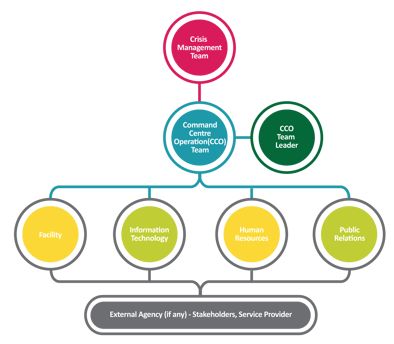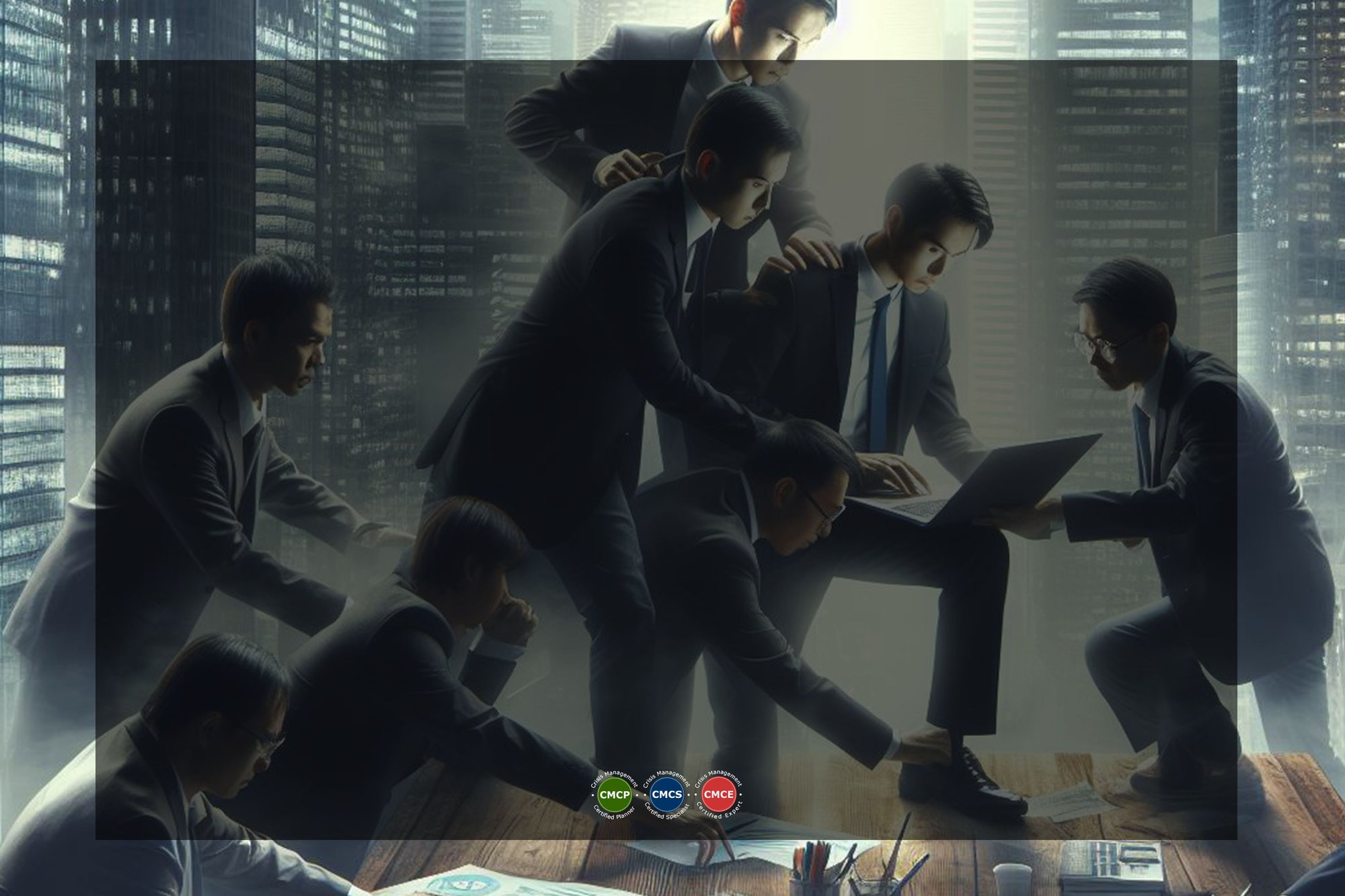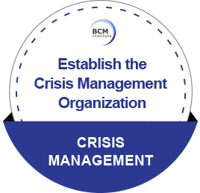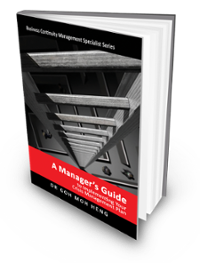Objectives of Crisis Management
The implementation of the Crisis Management (CM) program for any organisation has four main objectives:
- Reduce tension during the incident.
- Demonstrate corporate commitment and expertise.
- Control the flow and accuracy of the information.
- Manage resources efficiently.
One of the contributing factors to meeting these objectives is establishing a crisis management organisation.
Forming the Team
A typical CM organisation can begin by establishing:
- Crisis Management Planning Team (CMP Team)
- Crisis Management Team (CM Team)
- Command Centre Operation Team (CCOT)
- Crisis Communication Team
- Incident Management Team (IMT or IM Team)
Composition of a Crisis Management Team

Composition of CM Team
Crisis Management Planning (CMP) Team
This team operates during “peacetime”, and the primary roles of the CMP team are to:
- Determine the scope of the CM project.
- Design all responses to anticipated crises.
- Review the policies and crises regularly.
Also, the CMP team:
- Designates the command centers.
- Plans and prepares for testing and exercising the crisis management plans.
- Ensures the effectiveness and preparedness of the CM system.
The CM Planning Team should be as small as possible. Its tasks are to oversee the devising of an effective CM plan, ensure a training and testing schedule, and secure the resources for carrying out the plan's requirements.
During "peacetime", you may experience the setup of a senior management-led team called the Crisis Management Steering Committee. If your organisation has a dedicated Crisis Management Planning Team, this committee will oversee the planning team.
Crisis Management Team (CMT)
A CMP Team is a group of assigned individuals with the skills and professional discipline to respond effectively to a crisis. In its pre-crisis mode, it is responsible for evaluating policy options and, in conjunction with the CM Team, formulates corporate crisis management policies.
Should an incident occur, the CM Team assumes responsibility for assessing the threat and directs all crisis management activities within the parameters of its charter.
CM Team consists of key executives, essential key supporting players, and heads of business with critical functions. Each member has a set of pre-defined roles and responsibilities for implementing the CM Plan.
The CM Team can include legal counsel, investigators, public relations or corporate communications and human resources. It also provides investor relations, risk management, financial, marketing, information technology, employee relations, facilities or property, and engineering.
During a crisis, the main tasks of the CM Team are to:
- Prepare and approve information for the general public.
- Prioritize operations and consider legal implications.
- Coordinate with the Command Centre Operations (CCO) Team.
- Approve the declaration of the CM, BC, and DR plans.
The CMT does not need to be an original executive management team as not every business unit needs to be represented.
Crisis Communication Team
The Crisis Communication team usually forms part of the Crisis Management team. Its primary role is to formulate a public response to a crisis. The tasks for the team during a crisis are to:
- Formulate a detailed plan in the event of a possible crisis.
- Organize all information that is delivered to the media.
- Designate a primary spokesperson.
Manage all internal communication and provide updates to employees.
Command Centre Operation (CCO) Team
The CCOT is the second team to be set up. It should draw on steady, reliable, experienced people who can function in the Command Centre. Their tasks during a crisis are to:
- Activate the CM plan and system upon declaration by the CM Team.
- Establish a communication network.
- Evaluate the need for medical services.
- Access fire danger.
- Engage search and rescue efforts.
- Provide support for emergency responders.
- Coordinate communication efforts with the larger.
- Any other duties that the CMT designates.
In general, this team should make the tactical decisions to ease the crisis. There should be an identified CCOT Leader.
Incident Management (IM) Team
Depending on the nature of the incident, other organisation locations may be directly or indirectly affected.
Local Management Teams, called Incident Management Teams, are responsible for carrying out corporate policy and operational recovery as it affects them and as directed by the (Headquartered) Crisis Management Team. This team may also be called the Site Response Team, which reports to the Headquarters team.
The tasks of the IT team during a crisis at the location are to:
- Activate the response system upon declaration by the CM Team and CCO team.
- Coordinate with the civil authorities and resources, such as the police, ambulance services, and search and rescue.
Roles of Team Leaders and Members
CM Planning (CMP) Team Leader
A CMP Team Leader should report to the CEO. In some instances, this Team Leader reports to a CFO, Chief Legal Counsel, or Director of Communications. The concern is that this reporting risks the Team leader being pigeonholed into one discipline, defeating the purpose of an effective, functioning CM team, which should be cross-disciplinary.
This person is in charge of the entire CM team. He or she has the final say in any decisions that must be made and directs the actions of other team members. The CM team regularly gives the team leader status updates and flags any issue that needs immediate attention. The team leader is often the Chief Executive Officer or a direct appointee of the CEO or Chairman.
The CEO should ensure representation from:
- Finance
- Operations
- Safety/ Security
- Law
- Communications
- Marketing
- Human Resource/ Labour
Spokesperson
In today's media environment, professional and citizen journalists, through social media, take an immediate interest in crisis situations.
The CM team's spokesperson conducts press conferences, fields phone calls, drafts press releases, and prioritizes interviews with other officials if necessary.
The spokesperson also monitors ongoing media coverage for accuracy or has additional team members who do so and report to him.
This person usually has an everyday communications role, such as a media officer or public relations professional. Refer to Manage Crisis Communication.
Command Centre Operations (CCO) Team Leader
This person or people (could rotate this position but ensure it is always filled) stays in the Command Centre and assures the members are working with the most current information.
Appointed by and assists the CM Team Leader in managing the CM team activities, including:
- Record information and comments from the CM team.
- Make the CM team leader aware of new information.
- Record and log chronologically.
- Update CM team members as they arrive or return to the centre.
- Record questions from CM team members that can be used as prompts for communication between the corporate and IM team leaders and follow-up by the team.
- Assist CM Team Leader in managing CMT activities.
- Track/document critical phone numbers and contacts that may not be predetermined before the crisis (e.g., the hotel where the crisis site team is operating during a disaster)
Command Centre Operations (CCO) Team Member
If not a particular individual, these duties need to be assumed by one or more team members:
- Provide computer support to access data and procedures.
- Operate and relay faxes.
- Provide copies of documents.
- Provide weather conditions from the internet.
- Gather information that may be needed.
- For example, a Transportation Company or restoration contractor could help access the CM schedule and calendar.
- Helped set up the command centre room.
- Make sure telecommunication equipment is ready.
Goh, M. H. (2016). A Manager’s Guide to Implement Your Crisis Management Plan. Business Continuity Management Specialist Series (1st ed., p. 192). Singapore: GMH Pte Ltd.
Extracted from Establish the Crisis Management Organisation
More Information About Crisis Management Courses





![[CM] Roles: Establish CM Team](https://no-cache.hubspot.com/cta/default/3893111/415a6fa2-73cd-49b8-a965-86d4d02b4aeb.png)






![[BL-CM] [5] Register](https://no-cache.hubspot.com/cta/default/3893111/82024308-16f4-4491-98be-818a882c6286.png)

![Email to Sales Team [BCM Institute]](https://no-cache.hubspot.com/cta/default/3893111/3c53daeb-2836-4843-b0e0-645baee2ab9e.png)





